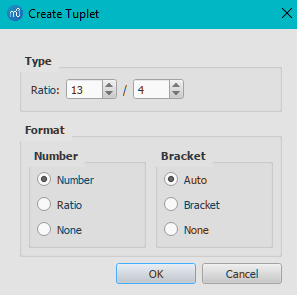Tuplets
Tuplets are used to write rhythms beyond the beat divisions usually permitted by the time signature. For example, a triplet consists of three notes in the time of two:

And a duplet consists of two notes in the time of three:

Create a tuplet
The exact method of tuplet entry depends on whether you are starting off in Note input mode or Normal mode. We'll start off with a simple example: the creation of an eighth note triplet.
Create a triplet in normal mode
-
Select a note or rest that specifies the full duration of the desired triplet group. In the case of an eighth note triplet, you will need to select a quarter note or rest—as in the example below:

-
Press the keyboard shortcut for a triplet, Ctrl+3 (Mac: Cmd+3); alternatively use the menu, Add→Tuplets→Triplet. This will give the following result:

-
The program automatically changes to note-input mode and selects the most appropriate duration—in this example an eighth note. Now enter the desired series of notes/rests. For example:

Alternatively, use the Duration Editor to switch between tuplet and non-tuplet.
Create a triplet in note input mode
- Ensure you are in note input mode (press N).
- Navigate to the note/rest (or blank measure) where you want the triplet to start (use the left/right arrow keys as required).
- Select a final duration for the whole triplet group. In the case of an eighth note triplet, click on the quarter note in the note input toolbar (or press 5 on the keyboard).
- Press the keyboard shortcut for a tuplet, Ctrl+3 (Mac: Cmd+3); alternatively, use the menu, Add→Tuplets→Triplet. This creates a triplet number/bracket and appropriately divides the original note/rest (see image above).
- The program automatically selects the most appropriate duration—in this example an eighth note—allowing you to immediately start entering the desired series of notes/rests.
Create other tuplets
To create other tuplets substitute one of the following commands at the relevant step above:
- Press Ctrl+2–9 (Mac: Cmd+2–9). 2 for a duplet, 3 for a triplet etc.
- From the menu, select Add→Tuplets, then click on the desired option.
For more complex cases, see below.
Custom tuplets
To create other tuplets than the default options (e.g. 13 sixteenth notes in the space of one quarter note):
- In Note input mode, select a note duration equaling the total duration of the tuplet; or, if in Normal mode, select a note or rest of the desired overall duration;
- Open the Create Tuplet dialog from the menu: Add→Tuplets→Other...;
-
Select the desired number ratio (e.g. 13/4 for thirteen sixteenth notes in the space of a quarter note) under "Relation" in the "Type" section. Specify "Number" and "Bracket" using the radio buttons in the "Format" section;

-
Click OK to close the dialog:

-
Enter the desired series of notes/rests.
Triplet examples

Delete a tuplet
Use either of the following:
- Select the number or bracket and press Del.
- Select any element of the tuplet, then in the Note section of the Inspector press the "Tuplet" button (bottom right), and press Del.
- Select the entire tuplet, using the shift + click method, then press Del.
- Use the Duration Editor to switch between tuplet and non-tuplet.
Change display of tuplets
Using the Inspector
To change the display properties of tuplets in the score, select the tuplet numbers/brackets, and adjust the desired properties in the "Tuplet" section of the Inspector:
- Direction: 'Auto' places the bracket/number in the default position. 'Up' always places the bracket above the note heads; 'Down' always places the bracket below the note heads.
- Number type: Choice of 'Number', 'Ratio', or 'Nothing'.
- Bracket type: 'Automatic' hides the bracket for beamed notes and shows the bracket if the tuplet includes unbeamed notes or rests. 'Bracket' displays the bracket. 'None' hides the bracket.
Using the Tuplets Style dialog
To make fine adjustments to the way that all tuplets in the score are displayed: from the menu, select Format → Style...→Tuplets.
The legend below illustrates some of the properties that can be adjusted in the Tuplets style dialog:

(2) Vertical distance from stem.
(3) Vertical distance from note head.
(5) Distance before stem of first note.
(6) Distance after stem of last note.
External links
- How to create triplets and other tuplets (MuseScore HowTo)
- How to create nonstandard tuplets (MuseScore HowTo)
- How To create triplets and other tuplets across measures (MuseScore HowTo)
- Tuplet at Wikipedia
- The User Guide to Tuplets in MuseScore [video]